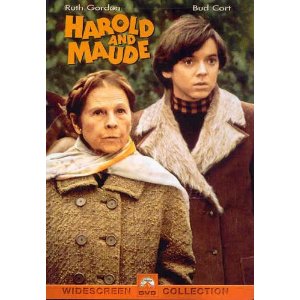“Zoos are full, prisons are overflowing… oh my, how the world still dearly loves a cage.” – Maude (Ruth Gordon)
As Harold and Maude is being released on blu-ray and on The Criterion collection it seems fitting to review the film.
Harold and Maude opens with twenty year old Harold Chasen (Bud Cort) hanging himself in a mock suicide attempt to gain his mother’s attention. She reacts calmly and tells him to get down and prepare himself for dinner. At the table and among guests, his upper-class, sophisticated mother (Vivian Pickles) treats him like a boy and tells embarrassing stories about him and his father. Afterwards, Ms. Chasen retreats to her bathroom to find her mirror covered in fake blood, and Harold pretending to be dead in a pool of blood in the bathroom with a slit throat and slit wrists. She becomes upset and insists Harold see a psychiatrist.
He willingly goes, and when the doctor poses what he does for fun, Harold answers that he goes to ‘funerals.’ At one in particular, he meets Maude (Ruth Gordon) a woman nearing her eightieth birthday. Maude is the opposite in a many ways of what Harold shows on the outside. She loves life and lives each moment to the fullest. She steals cars, poses nude for art, and drives like a maniac. She enjoys recounting her entire life to him and he finds himself drawn to hearing it. After she steals his car and offers him a ride home, the two form a tight friendship that evolves into more.
As Harold’s obsession with death continues, he drives his hearse around town, and deals with his mother’s awful attempts at solving his problems. She begins by having his uncle talk to him and attempt to enlist him in the armed forces. “You’ll get to see the war, first hand,” the one-armed solider promises with a smile as pictures of Richard Nixon and Nathan Hale decorate his office.
Harold leaves without committing to anything and soon Ms. Chasen decides what he needs is the love of a good woman and to get married. She fills out a dating service questionnaire on his behalf, answering each one the way she would and not even thinking about what Harold‘s response to any of the questions may be. Soon, young ladies begin to visit him and he turns each one off and offends them by pretending to commit suicide.
As the chaos of his home-life ensues, he begins spending time with Maude. Upon seeing him at his second funeral, Maude approaches him and offers him some licorice. They have a quick chat and then she steals the priest‘s car and drives away nearly hitting everything around. Soon, the two begin a relationship, that one would be inclined to classify as ‘odd‘ but in actuality it is anything but. In fact, considering who the individuals are, it‘s very fitting. Maude becomes the only person that Harold feels comfortable with and soon he experiences love for the first time. His love for death is replaced with Maude’s love for life. Though his mother and psychiatrist both oppose the union, he pays them no mind and buys a ring with the intent of proposing to her.
Much like “The Graduate,” used Simon and Garfunkel to add to the atmosphere, setting and overall tone of the film, “Harold and Maude” utilized music by the amazing Cat Stevens to do the same. It works magnificently in the film and actually helps tell the story as we view it.
“Harold and Maude” is unlike any film made before or after. The union between the two characters is something unique and special. Whereas a love affair between a twenty year old man and an eighty year old woman would generally come across as unrealistic or too bizarre to get invested in, Bud Cort and Ruth Gordon made their characters not only believable but the relationship is displayed in what can only be described as a natural progression. The connection becomes not only something the audience believes, but something they root for.
The film relies completely on the two leads. The entire production falls onto their shoulders, and the delivery could not be better. Bud Cort played the very quiet and uncertain Harold as both sympathetic and strange. The character sits somewhere in between Psycho’s Norman Bates and Jim Stark from A Rebel Without a Cause.
Ruth Gordon as always delivered a magnificent performance. Horror fans may remember her more from Rosemary’s Baby as the very creepy Minnie Castevet. Maude however is the near complete opposite. Both characters were outgoing and a bit pushy, but Maude’s love for life and experiencing everything new makes the two very distinct from one another.
Harold and Maude is both hilarious and touching. It’s a film type that could have only been bred in the 70s. It pushed a societal envelope while remaining innocent and sweet. It made philosophical points and encouraged thinking outside of the box making the audience laugh all the while.
A recent film, Charlie Bartlett attempted to recapture some of the energy of “Harold and Maude.” It even used “If you want to sing out, sing out,” by Cat Stevens. It was by far a better comedy than most that are made today, but even with a valiant effort, the perfection of Harold and Maude remains untouchable.
RATING: 10/10
